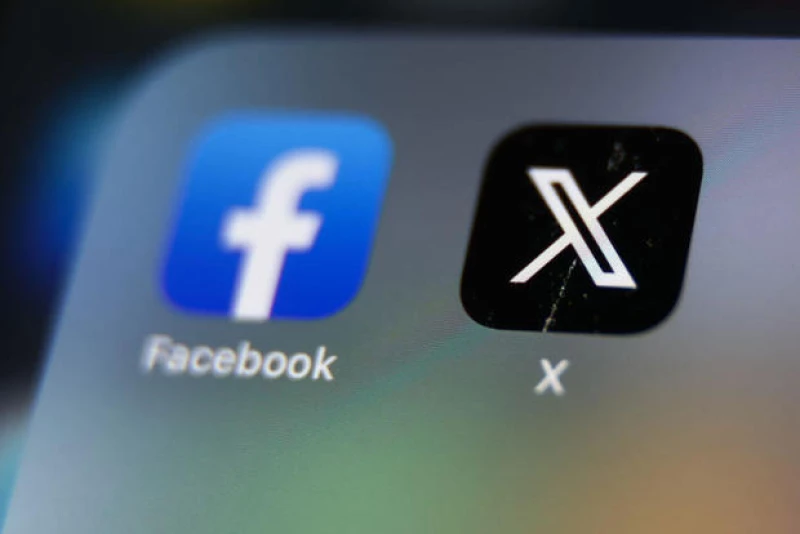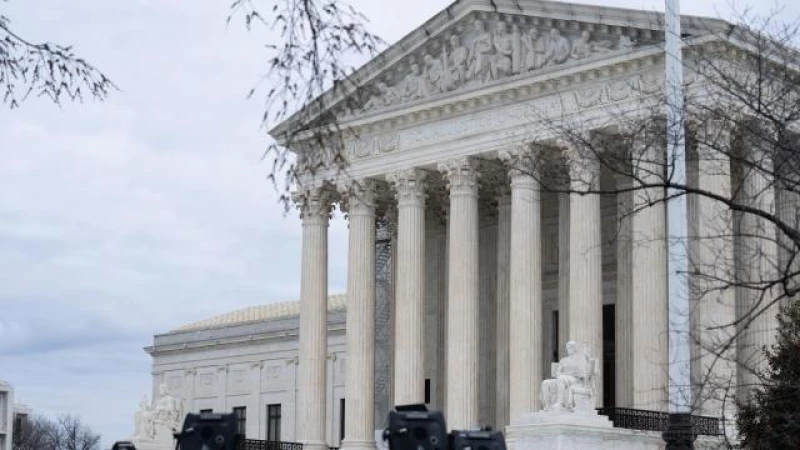Washington — The Supreme Court on Monday will be weighing whether the government crossed a constitutional line into censorship of lawful speech when it pressured social media platforms to take down content it deemed misleading.
The case poses a significant test of the First Amendment's free speech protections in the digital age and stems from the Biden administration's efforts to pressure social media platforms to remove content that it said spread falsehoods about the COVID-19 pandemic and the 2020 presidential election.
The Supreme Court is set to consider at what point the federal government's attempts to protect against misinformation on social media cross into censorship of speech that is constitutionally protected.
"The key free speech issue is how far can the government go in verbally arm-twisting private speech intermediaries to remove speech before that constitutes a First Amendment violation or state action," said Clay Calvert, a law professor at the University of Florida who is an expert in the First Amendment.
In addition to the social media case, known as Murthy v. Missouri, the Supreme Court on Monday will also hear a dispute over whether a New York financial regulator violated the National Rifle Association's free speech rights when she pressured banks and insurance companies in the state to sever ties with the gun rights group.
At the core of both cases is so-called jawboning, or informal pressure by the government on an intermediary to take certain actions that will suppress speech. In the first dispute, the intermediaries are the platforms, and in the second case, the intermediaries are insurance companies.
"In both cases, the government doesn't actually have the power to regulate speech or to decide whether the NRA can access banking institutions or not," said Will Duffield, a policy analyst at the libertarian Cato Institute, adding that "the government is seemingly gaining, gathering, usurping new powers by leaning on these intermediaries in order to do things that it isn't authorized to do itself."
The social media case
The first legal battle before the court arose out of the Biden administration's efforts to pressure platforms including Twitter, now known as X, YouTube and Facebook, to take down posts about COVID-19 and the 2020 election that it believed spread misinformation.
The dispute was brought by five social media users and two states, Louisiana and Missouri, who claimed their speech was stifled when platforms removed or downgraded their posts after strong-arming by officials in the White House, Centers for Disease Control, FBI and Department of Homeland Security.
The challengers claimed that at the heart of the legal battle lies a "massive, sprawling federal 'Censorship Enterprise'" through which federal officials communicated with social media platforms with the goal of pressuring them to censor and suppress speech they disfavored.
A federal district judge in Louisiana found that seven groups of Biden administration officials violated the First Amendment because they transformed the platforms' content-moderation decisions into state action by "coercing" or "significantly encouraging" their activities. U.S. District Judge Terry Doughty limited the types of communications agencies and their employees could have with the platforms, but included several carve-outs.
The U.S. Court of Appeals for the 5th Circuit then determined that certain White House officials and the FBI violated free speech rights when they coerced and significantly encouraged platforms to suppress content related to COVID-19 vaccines and the election. It narrowed the scope of the district court's order but said federal employees could not "coerce or significantly encourage" a platform's content-moderation decisions.
The Justice Department appealed to the Supreme Court, and the justices agreed to decide whether the Biden administration impermissibly worked to suppress speech on Facebook, YouTube and X. The high court temporarily paused the lower court's order limiting Biden administration officials' contact with social media companies.
In filings with the court, the Biden administration argued that the social media users and states lack legal standing to even bring the case, but said officials must be free "to inform, to persuade, and to criticize."
"The court imposed unprecedented limits on the ability of the president's closest aides to speak about matters of public concern, on the FBI's ability to address threats to the nation's security, and on CDC's ability to relay public-health information," Solicitor General Elizabeth Prelogar, who represents the government before the Supreme Court, said.
She argued that senior Biden administration officials were using the bully pulpit to push social media companies to address falsehoods on their platforms, which has never been a free speech violation. As long as the government is seeking to inform and persuade, and not compel, Prelogar wrote, its speech does not run afoul of the First Amendment.
"Influence is also the natural result of successful efforts to inform, to persuade, or to criticize," Prelogar wrote. "That the platforms often acted in response to the government's communications thus does not remotely show that those communications were coercive."
But state officials behind the challenge told the court that accepting the Justice Department's argument would make the First Amendment "the easiest right to violate."
White House officials, they said, frequently coupled private demands for social media companies to remove posts with public references to adverse consequences they could initiate, such as antitrust reforms or changes to the law that protect platforms from civil liability over content posted by third parties.
"By silencing speakers and entire viewpoints across social-media platforms, defendants systematically injure plaintiffs' ability to participate in free online discourse," state officials from Louisiana and Missouri wrote.
The legal fight is one of five that the justices are weighing in their current term that stand at the intersection of the right to free speech and social media. But in this case, the key question for the justices is whether the Biden administration was engaging in permissible persuasion or unlawful coercion when it urged social media platforms to suppress content.
"It's going to have to define those rules about what speech is allowed and what's not, how far can the government go before it violates the First Amendment rights of the individuals who are posting on the speech intermediaries," Calvert said.
The Biden administration has said it is vital for federal officials to be able to communicate with social media companies on issues of public consequence, and using strong or critical language does not mean it's crossing a constitutional line.
But David Greene, civil liberties director at the Electronic Frontier Foundation, said U.S. officials will not lose their ability to combat misinformation or disinformation. The government, though, has a responsibility to ensure people don't perceive it as forcing their hands, he said.
"There are two main issues, and that is what do courts look at to determine whether and at what point a government crosses the line from voicing its opinion about how a social media platform should treat a specific post to unconstitutionally coercing the censorship, the negative moderation of that post," he said. "There's no disagreement that there is a point at which it becomes unconstitutional, but what the parties disagree on is what is that line and what is the appropriate analysis for setting that line, what factors to consider?"
Any cases that present close calls should go against the government, Greene said, because officials are "best placed to moderate their behavior to make sure it's not interpreted as coercive."
The NRA's legal battle
In the second case, the court will consider whether the former superintendent of the New York State Department of Financial Services violated the NRA's free speech rights when she pushed regulated insurance companies and banks to stop doing business with the group.
Former Superintendent Maria Vullo, who departed her position in 2019, had been conducting an investigation since 2017 into two insurers, Chubb and Lockton, involved in NRA-endorsed affinity programs. The investigation revealed that these insurers were in violation of state insurance laws. Additionally, it was found that Lloyd's of London also underwrote similar unlawful insurance products for the NRA.
Following the Parkland shooting in April 2018, Vullo issued guidance letters advising regulated entities to assess and manage any risks, including reputational risks, that could arise from their associations with the NRA or similar gun rights organizations.
Later that year, the Department of Financial Services reached consent decrees with the three insurance companies collaborating with the NRA. As part of the agreements, the insurers acknowledged their involvement in providing illegal NRA-supported programs and agreed to cease offering these policies to residents of New York.

In response, the NRA filed a lawsuit against the department, alleging that Vullo had privately threatened insurers with enforcement actions if they continued their partnerships with the group. The NRA claimed that Vullo had established a system of "informal censorship" intended to suppress its speech, thereby violating the First Amendment.
A federal district court ruled in favor of the NRA, stating that the group had presented sufficient evidence to suggest that Vullo's actions could be construed as a veiled threat to industries under regulation to sever ties with the NRA or face potential enforcement actions by the DFS.
After a federal appeals court ruling, it was determined that the guidance letters and a press release were not unconstitutionally threatening or coercive, as they were written in a neutral tone to persuade rather than intimidate.
The NRA took the case to the Supreme Court, which agreed to review whether Vullo violated the group's free speech rights by encouraging financial institutions to cut ties with them.
Arguing that penalizing unpopular speech under the guise of 'reputational risk' would undermine the First Amendment, the NRA, with representation from the ACLU, made their case in a filing to the court.
The NRA claimed that Vullo singled them out for their political speech and used her regulatory power to pressure financial institutions into blacklisting the organization, ultimately succeeding but violating the First Amendment in the process.
However, Vullo defended her actions by stating that the insurance products offered by the NRA were illegal, pointing out that the NRA had previously signed a consent order with the department for marketing insurance without the required state license after she had left her position.
State Lawyers Warn of Dangerous Precedent in NRA Case
State lawyers have warned that accepting the NRA's arguments in a recent Supreme Court brief would set an exceptionally dangerous precedent. The lawyers argued that such a decision would encourage damages suits and deter public officials from enforcing the law, even against entities like the NRA that have committed serious violations.
The NRA is seeking favored status based on its controversial views, according to the state lawyers. They also noted that the group has never claimed it was unable to exercise its free speech rights.
A decision from the Supreme Court in both cases is expected by the end of June.
Source: Supreme Court Brief







